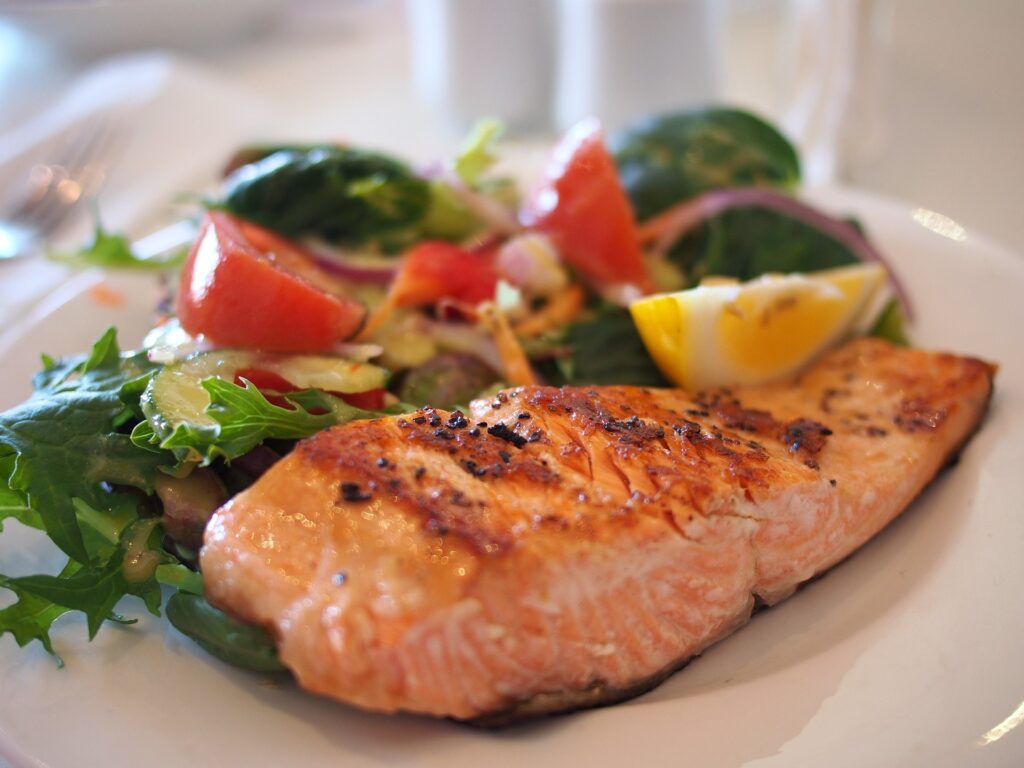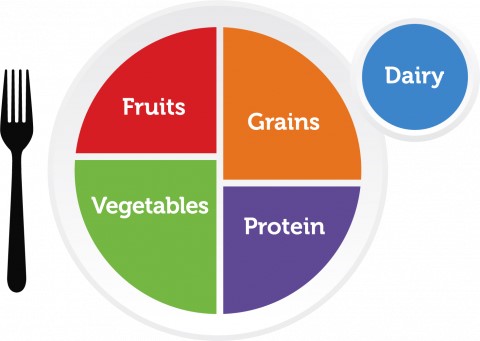Eating Your Way to Health and Well-Being
 Salad and Salmon Plate
Salad and Salmon Plate
by Audrey Demmitt, R.N.
Healthy eating is the cornerstone of healthy living. Food provides the fuel, nutrients, vitamins, minerals, and water our bodies require to function well. A balanced, nutritious diet can be like medicine to our bodies, helping them to heal and fight illness. You alone are responsible for eating healthy foods which can make all the difference in the way you feel. So, how are you feeding your body, and is there room for improvement?
The American Way of Eating
We are literally what we eat. Choosing nutrient-dense foods and beverages from all five food groups in the right amounts can promote health and prevent diseases. Unfortunately, most Americans are not eating this way, and the prevalence of obesity and diet-related chronic disease in the U.S. is concerning.
The 2020-2025 Dietary Guidelines for Americans (DGA) offers advice to help Americans improve their eating habits. These guidelines emphasize the importance of a healthy dietary pattern for people across the lifespan, and they are based on the premise that we can all make shifts and better choices in our eating patterns. The DGA is a framework, not meant to be a rigid, prescriptive diet. There is room for tailoring them to fit personal and cultural preferences. Visit their website to discover ways to eat healthier.
Recommendations to Improve Your Eating Pattern
The DGA says the American diet is high in added sugars, saturated fat, and sodium. This can also mean a diet with more empty calories, depriving our bodies of necessary nutrients. We should limit:
• Added sugars to <50 grams a day.
• Saturated fat to <22 grams a day.
• Sodium to <2,300 milligrams a day.
Here are other DGA recommendations to improve the typical eating pattern:
- Eat a variety of foods in each group. Try new kinds of fruits, vegetables, grains, and protein-rich foods, and eat within your calorie limit.
- Eat foods as close to their natural form as possible (orange instead of orange juice or old-fashioned oats instead of instant oatmeal) and limit processed foods. This will improve the nutrient value of your food choices.
- Increase dietary fiber by eating more whole grains, vegetables, beans, and whole fruit.
- Choose whole grains instead of refined grains (brown rice in place of white rice or whole wheat bread instead of white bread).
- Get calcium and vitamin D with low-fat or nonfat dairy options or fortified dairy alternatives like soy, almond, and oat drinks.
- Choose lean protein sources like lean meats, chicken, fish, nuts, tofu, and beans more often.
- Focus on healthy fats (olive oil, canola oil, avocado, and nuts) and avoid or limit unhealthy fats (animal fats, saturated fats, trans fats, and fried foods).
- Limit alcoholic beverages (2 drinks for men and 1 drink for women, per day), which tend to be “empty” calories.
MyPlate: A Simple Plan for Healthy Eating
 Healthy Eating Plate with Vegetables, Fruits, Grains, and Protein
Healthy Eating Plate with Vegetables, Fruits, Grains, and Protein
Sourced from U.S. Department of Agriculture at www.MyPlate.gov
MyPlate, based on the Dietary Guidelines for Americans, is a simple way to start a meal plan that is right for you. It is not a diet but a guide to help you choose nutritious foods from all five food groups and stay within your calorie limit. Visit the MyPlate Plan to learn more about your nutritional needs and calculate your daily calorie requirement based on age, sex, height, weight, and physical activity level. You will be able to download a customized eating plan. Then think about swaps or changes you can make to move closer in line with the Dietary Guidelines for Americans.
Make Small Changes and Better Choices
Making small changes and better choices in your dietary pattern can kickstart sustainable and positive lifestyle changes. You may want to consider your current eating habits, ask yourself what changes you can make, and set goals. Track your food and beverages to help you learn about their nutrient and calorie content and discover areas that need adjustment. Think of your personal calorie requirement as a “food budget” and how you want to spend it each day. Ask yourself questions like:
- Will this food be nutritious for my body?
- Am I eating enough protein?
- How can I add more vegetables to my meals?
- Is that extra glass of wine or dessert worth the calories?
Be mindful and informed about what you are feeding your body.
How Much is Enough?
Many Americans have “portion distortion” and have no idea what healthy portions look like on a plate. So, check serving sizes on nutrition labels and measure your foods to adjust your portions. Learning how to read nutrition labels is key, and there are videos, PDFs, and worksheets online to teach you this skill. There are accessible apps for tracking food intake (Lose It, Fitbit health trackers) to help you stay within your calorie limit.
Another key strategy is weighing yourself every day to monitor weight changes. Research shows people who track their foods and weigh daily are more successful with weight management.
There are a few more things to consider if you want to improve the quality of your eating plan. Eating healthy will involve adapting cooking methods and shopping behaviors. Learn to cook foods in healthier ways like sautéing, steaming, roasting, and baking. Learn to buy the most nutritious foods at the grocery store to get more nutritional bang for your buck. Healthy eating does not have to be expensive, and many wholesome options are budget-friendly. Here, you will find tips for eating healthy on a budget.
Eating Out
Many Americans are eating out more often than eating home-cooked meals. Restaurant meals tend to be high in sugar, salt, fat, and calories, and portions are often too large. You can learn to make healthier choices when dining out, and you may consider cooking at home more often so your efforts to eat healthy aren’t sabotaged.
Healthy Eating When Overweight, Obese, or Prediabetic
Weight loss can be a real struggle and requires a commitment to a healthier eating pattern. Most fad diets do not work and may even be unhealthy. Most nutrition education programs are moving away from specific diets and are teaching people to eat real foods in healthy amounts.
The most successful weight loss programs teach proper nutrition, build in a support component, and encourage sustainable lifestyle changes. Healthy weight loss takes time, patience, and effort. You may find several resources helpful when you are ready to focus on better health through weight loss.
Resources
- The National Diabetes Prevention Program is a CDC-recognized lifestyle change program that will teach you to eat healthy, move more, and stress less. According to the website, key components of the program include:
a. CDC-approved curriculum with lessons, handouts, and other resources to help you make healthy changes.
b. A lifestyle coach specially trained to lead the program to help you learn new skills, encourage you to set and meet goals, and keep you motivated. The coach will also facilitate discussions and help make the program fun and engaging.
c. A support group of people with similar goals and challenges. You can share ideas, celebrate successes, and work to overcome obstacles.
This program is available across the U.S. in virtual or in-person formats. Check out the details, including the criteria to join, what you will learn, and the time commitment on the website. It is an evidence-based program that can help you develop new healthy habits. Most programs are free.
2. Your health insurance may offer a weight management program, including nutrition education, a support community, health coaches, free scales, and apps to help you track food and activity. Livongo® is one example of a program offered through employer insurance plans, but there are others that are usually free.
Committing to feed your body nutritious foods is an investment in your health and quality of life. It is a loving act of self-care to make changes to improve your eating habits. When you give your body what it needs, it will perform the way you need.
by Audrey Demmitt, R.N.